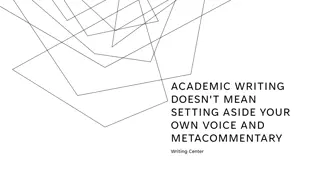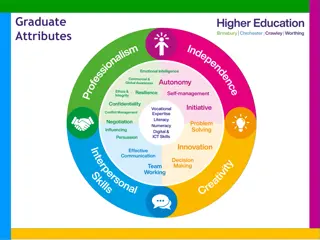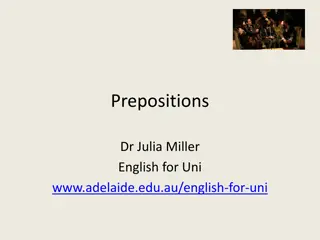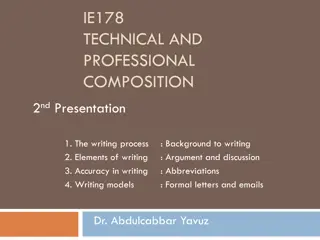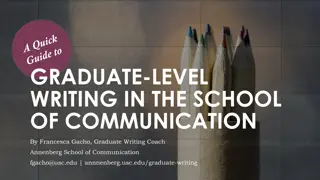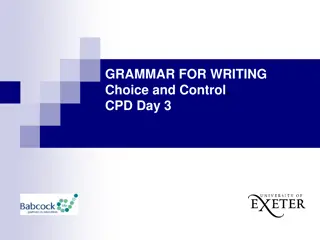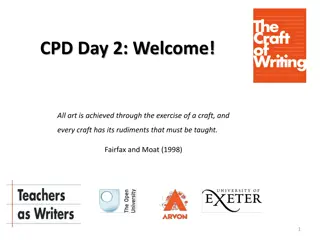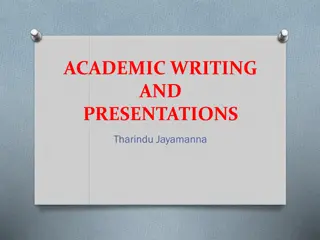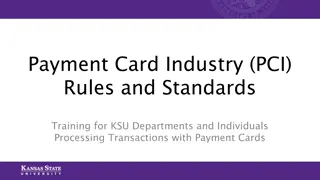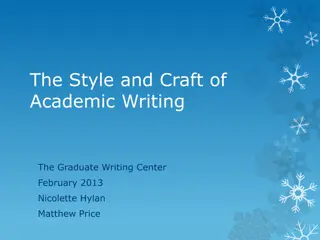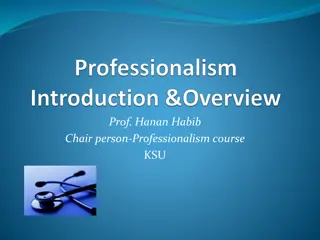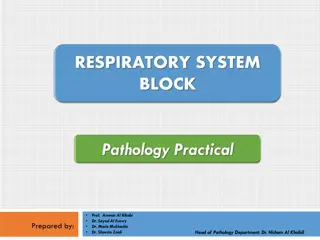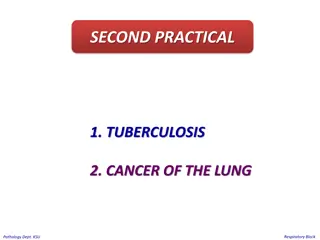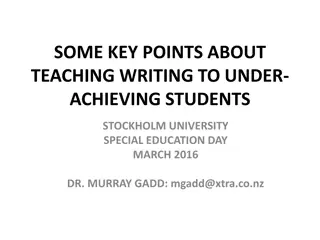Academic Insights: Online Teaching & Writing Strategies at KSU
Explore the academic offerings and vision at Kansas State University through the lens of Patricia E. Ackerman, Ph.D., a distinguished Professor of Language Arts. Discover courses taught, student learning outcomes, critical thinking skills, and the importance of clear communication. Delve into traditional academic writing styles and the significance of technical communication in academia.
Download Presentation

Please find below an Image/Link to download the presentation.
The content on the website is provided AS IS for your information and personal use only. It may not be sold, licensed, or shared on other websites without obtaining consent from the author. Download presentation by click this link. If you encounter any issues during the download, it is possible that the publisher has removed the file from their server.
E N D
Presentation Transcript
Patricia E. Ackerman, Ph.D. Professor of Language Arts Kansas State University Polytechnic KSU Learning Center Presentation Wednesday, April 28, 2021 Noon 1:00 p.m. KSU Online Teaching: Through the Lenses of Technical Writing, Readability, & Plain Language
Courses Taught at KSU KSU Expository Writing I & II Advanced Technical Communication Introduction to Critical Thinking Business Ethics Public Speaking American Literature Mastering Academic Conversations Technical Communication
KSU Academic Vision KSU Kansas State University strives to create an atmosphere of intellectual curiosity and growth, one in which academic freedom, breadth of thought and action, and individual empowerment are valued and flourish. We endeavor to prepare citizens who will continue to learn and will contribute to the societies in which they live and work.
Kansas State University Undergraduate Student Learning Outcomes KSU Knowledge Academic & Professional Integrity Diversity Awareness Communication Critical Thinking Adopted by KSU Faculty Senate April 13, 2004 http://www.k-state.edu/assessment/slo/undergradobj
KSU Critical Thinking SLO Students will demonstrate the ability to access and interpret information, respond and adapt to changing situations, make complex decisions, solve problems, and evaluate actions. Communication SLO Students will demonstrate the ability to communicate clearly and effectively. 2020 magnified the importance of these skill sets.
Online Teaching Considerations KSU Technical Writing Readability Plain Language
Traditional Academic Writing KSU Research Papers Essays Reports Articles Oral Presentations Outlines Annotated Bibliographies Primary Audience Instructor, Peers, Educated Audiences Objectives Demonstrate rhetorical understanding, inform, persuade, receive a grade, earn a degree.
Technical Communication KSU Technical communication encompasses a set of activities that people do to discover, shape, and transmit information. (Markel 2019) Technical writing helps users solve problems, learn about a subject, carry out particular tasks, or make decisions. Technical documents should motivate readers to take action. Audience Peers, supervisors, customers, clientele, diverse educational levels (clearly define users, purpose, prior levels of knowledge, expectations) Objective Help readers FIND, UNDERSTAND, and USE information effectively. (user-centered design)
Online Education KSU Technical communication encompasses a set of activities that people do to discover, shape, and transmit information. (Markel 2019) Technical writing helps users solve problems, learn about a subject, carry out particular tasks, or make decisions. Technical documents should motivate readers to take action. Audience Peers, supervisors, customers, clientele, diverse educational levels (clearly define users, purpose, prior levels of knowledge, expectations) Objective Help readers FIND, UNDERSTAND, and USE information effectively. (user-centered design)
Technical Writing Deliverables KSU Technical information might be communicated through: * Proposals * Emails * Blogs * Reports (Lab) * Wikis * Quick Ref. Guides * Manuals * Web pages * Letters * Memos * Posters * Power Points * Training Materials * Job Materials * Forms & Surveys * Contracts/Guidelines * Scientific Writing * Software Docs * Medical Writing * Business and Professional Documents * Podcasts * Online help files * Tutorials * Instructions/Directions * Infographics * Digital Media * Data/Statistics * Grant Writing Purple boldfaced text identifies ENGL302 Technical Writing assignments.
Online Teaching Considerations KSU Technical Writing Readability Plain Language
KSU Invitation to Explore Readability Analysis 1940 Rudolph Flesch, author, writing consultant, and supporter of the Plain English Movement. Austrian. PhD in English Columbia University. Advocated a return to phonics and proposed the Reading Ease Readability Formula. 1976 John P. Kincaid (et al) modified Flesch s formula for the U.S. Navy, producing a U.S. grade-level score. Identified as useful for educational purposes. (Over 40 readability formulas have been developed)
Flesch Reading Ease Score KSU Rates on a 100 point scale; the higher the score, the easier it is to understand the document. For most standard documents, aim for a score of approximately 60-70. Formula: Where: ASL = Average Sentence Length (number of words divided by number of sentences) and ASW = Average Number of Syllables Per Word (number of syllables divided by the number of words) 206.835 (1.015 x ASL) (84.6 x ASW)
Flesch Reading Ease Score KSU Score Interpretation: 90-100 Easily understandable by an average 11 year old student 60-70 Easily understandable by an average 13-15 year old student 0-30 Best understood by college graduates Reader s Digest Magazine Time Magazine Average Grade 7 Student Harvard Law Review 65 52 60-70 30
Flesch-Kincaid Grade Level Score KSU Rates text on a U.S. school grade level. For example, a score of 8.0 means that an 8th grader can understand the document. For most documents, aim for a score of approximately 7.0 to 8.0. Formula: (.39 x ASL) + (11.8 x ASW) - 15.59 Where: ASL = Average Sentence Length (number of words divided by number of sentences) and ASW = Average Number of Syllables Per Word (number of syllables divided by number of words)
Gettysburg Address Abraham Lincoln November 19, 1863 KSU Four score and seven years ago our fathers brought forth, on this continent, a new nation, conceived in Liberty, and dedicated to the proposition that all men are created equal. Now we are engaged in a great civil war, testing whether that nation, or any nation so conceived and so dedicated, can long endure. We are met on a great battle- field of that war. We have come to dedicate a portion of that field, as a final resting place for those who here gave their lives that that nation might live. It is altogether fitting and proper that we should do this. But in a larger sense we cannot consecrate we cannot hallow this ground. The brave men, living and dead who struggled here have consecrated it, far above our poor power to add or detract. The world will little not, nor long remember what we say here, but it can never forget what they did here. It is for us the living, rather, to be dedicated here to the unfinished work which they who fought here have thus far so nobly advanced. It is rather for us to be here dedicated to the great task remaining before us that from these honored dead we take increased devotion to that cause for which they here gave the last full measure of devotion that we here highly resolve that these dead shall not have died in vain that this nation, under God, shall have a new birth of freedom and that government of the people, by the people, and for the people, shall not perish from the earth. Flesch-Kincaid 10.7 Average Word Length 4.28
The Social Task of the Scientist in the Atomic Era (Princeton) Albert Einstein 1946 KSU The position in which we are now is a strange one which in general political life never happened. Namely the thing I refer to is this: To have security against atomic bombs and against the other biological weapons, we have to prevent war, for if we cannot prevent war every nation will use every means that is at their disposal; and in spite of all promises they make, they will do it. At the same time, so long as war is not prevented, all the governments of the nations have to prepare for war, and if you have to prepare for war, then you are in a state where you cannot abolish war. This is really the cornerstone of our situation. Now, I believe what we should dry to bring about is the general conviction that the first thing you have to abolish is war at all costs, and every other point of view must be of secondary importance. Flesch-Kincaid 13.4 Average Word Length 4.16
Chance for Peace Speech Dwight D. Eisenhower April 16, 1953 KSU In this spring of 1953 the free world weighs one question above all others: the chance for a just peace for all peoples. To weigh this chance is to summon instantly to mind another recent moment of great decision. It came with that yet more hopeful spring of 1945, bright with the promise of victory and of freedom. The hope of all just men in that moment was justice and lasting peace. This common purpose lasted an instant and perished. The nations of the world divided to follow two distinct roads. The way chosen by the United States was plainly marked by a few clear precepts, which govern its conduct in world affairs. This way was faithful to the spirit that inspired the United Nations: to prohibit strife, to relieve tensions, to banish fears. The way was to control and to reduce armaments. This way was to allow all nations to devote their energies and resources to the great and good tasks of healing the war s wounds, of clothing and feeding and housing the needy, of perfecting a just political life, of enjoying the fruits of their own toil. Flesch-Kincaid 8 Average Word Length 4.48
Inaugural Address Barack H. Obama January 20,2009 KSU My fellow citizens: I stand here today humbled by the task before us, grateful for the trust you have bestowed, mindful of the sacrifices borne by our ancestors. I thank President Bush for his service to our nation, as well as the generosity and cooperation he has shown through this transition. The words have been spoken during rising tides of prosperity and the still waters of peace. Yet, every so often the oath is taken amidst gathering clouds and raging storms. At these moments, American has carried on not simply because of the skill or vision of those in high office, but because We the People have remained faithful to the ideals of our forbearers and true to our founding documents. So it has been. So it must be with this generation of Americans Let it be said by our children s children that when we were tested we refused to let this journey end, that we did not turn back nor did we falter; and with eyes fixed on the horizon and God s grace upon us, we carried forth that great gift of freedom and delivered it safely to future generations. Flesch-Kincaid 12.0 Average Word Length 4.43
Practical Applications KSU Education Textbook Selection Many U.S. government and military agencies require documents/forms to meet specific readability levels. U.S. Dept. of Defense uses Flesch Reading Ease test as the standard of readability for documents and forms. Florida first required that life insurance policies have a Flesch- Kincaid score of 45 or greater. Google Docs, KWord, Lotus, Microsoft Word, WordPerfect and WordPro use Flesch-Kincaid Grade Readability tests. Audience analysis tool used by journalists and popular novelists.
Microsoft Readability Analysis Tool KSU When Microsoft Word finishes checking spelling and grammar, it can display information about the reading level of the document, including the Flesch Reading Ease Score and the Flesch-Kincaid Grade Level Score. Each of these readability score bases its rating on the average number of syllables per words (ASW) and the number of words per sentence (ASL). Microsoft Display of Readability Statistics 1. On the Tools menu, click Options, and then click the Spelling & Grammar tab. 2. Select the Check grammar with spelling checkbox. 3. Select the Show readability statistics check box, and then click OK. 4. On the Standard toolbar, click Spelling and Grammar.
Online Teaching Considerations KSU Technical Writing Readability Plain Language
Technical Communication To Enhance Online Learning KSU Technical communication encompasses a set of activities that people do to discover, shape, and transmit information. (Markel 2019) Technical writing helps users solve problems, learn about a subject, carry out particular tasks, or make decisions. Technical documents should motivate readers to take action. Audience Peers, supervisors, customers, clientele, diverse educational levels (clearly define users, purpose, prior levels of knowledge) Objective Help readers FIND, UNDERSTAND, and USE information effectively. (user-centered design)
Plain Language Principles can Enhance Readability of Online Curricula In October 2010 President Barack Obama signed Plain Language Legislation into law. All U.S. government agencies are required to develop Plain Language Protocols and train employees to produce more readable documents. FAA Plain Language Guidelines https://www.dropbox.com/s/g924veogo6ubdf9/Full%20Plain%20Language%20 Guidelines.pdf?dl=0 https://www.plainlanguage.gov/ https://www.ssa.gov/agency/plain-language/ FAA Plain Language Tutorial Modules https://www.faa.gov/about/initiatives/plain_language/basic_course/ Simplified Technical English Manual (European) https://www.dropbox.com/s/n2rqt8akn0tp4ap/ASD%20Simplified%20Technical %20English%20Manual%20-%207.0.pdf?dl=0 KSU
FAA Plain English Online Tutorial Modules KSU Part 1: Intro What is plain language? Part 2: Why use plain language? Part 3: Plain language law and tool kit Part 4: Plain language format tools Part 5: Plain language word tools Part 6: Pronouns and Active Voice Part 7: Review and Games Part 8: Final exam part A Part 9: Final exam part B FAA Plain Language Tool Kit https://www.faa.gov/about/initiatives/plain_language/media/toolkit.pdf
Plain Language Principles KSU Chunking of information White Space Bulleted lists Use of personal pronouns Active voice and active verbs Present tense Contractions San serif fonts Subheadings Graphics Layout & design FAA Plain Language Tool Kit https://www.faa.gov/about/initiatives /plain_language/media/toolkit.pdf
Online Teaching Considerations KSU Technical Writing Readability Plain Language
Building an Online Toolbox KSU Software Tutorials Plain Language Tutorials Help and Authoring Tools Grammarly Flow Charts & Planning Tools Graphic Design Tools Readability Analysis Tools Career Services Library Services Collaborators Time Management Tools
The 10 Skills Employers Most Want in 20-Something Employees (Forbes Magazine, 2013) KSU 1. 2. Ability to work as a team Ability to make decisions and solve problems Ability to plan, organize and prioritize work Ability to communicate verbally with people inside and outside an organization Ability to analyze quantitative data Ability to create and/or edit written reports Ability to sell and influence others Knowledge 3. Academic & Professional Integrity Diversity Awareness 4. 5. 6. Communication Critical Thinking 7.
References KSU Farr, J.N., Jenkins, J.J., and Paterson D.G. Simplification of Flesch Reading Ease Formula. Journal of Applied Psychology 35.5 (October 1951):333-337. Federal Aviation Administration. Plain Language. Accessed January 7, 2021. https://www.faa.gov/about/initiatives/plain_language/ Flesch, Rudolf. A New Readability Yardstick. Journal of Applied Psychology 32 (1948): 221-233. Flesch-Kincaid Readabilty Tests. Wikipedia. 2009. 4 April, 2009. http://www.en.wikipedia.org/wiki/Flesch- Kincaid_Readability_Test. Kincaid, J.P., R.P. Fishburne, R.L. Rogers, and B.S. Chissom. Derivation of New Readability Formulas (Automated Readability Index, Fog Count and Flesch Reading Ease Formula) for Navy enlisted personnel. Research Branch Report 8-75. Millington, TN: Naval Technical Training, U.S. Naval Station Memphis, TN. Markel, Mike and Stuart A. Selber. Practical Strategies for Technical Communication: A Brief Guide. 3rd Edition. Bedford/St. Martin s. Boston/New York. 2019. Readability Scores. Microsoft Office Online. 2009. 4 April 2009. http://office.microsoft.com/assistance/hfws.aspx. Rose, Mike. The Mind at Work: Valuing the Intelligence of the American Worker. 10th Edition. July 26, 2005. Penguin Random House Books. www.penguinrandomhouse.com.
KSU Thank you



